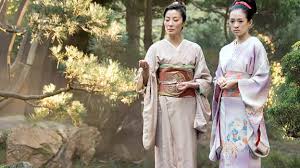3/13/2006
 Sony, two discs, color, PG-13, 145 min. plus supplements, Dolby Digital 5.1, widescreen, Street: March 28, $28.96; First Run: W, Dec. 2005, $56 mil.
Sony, two discs, color, PG-13, 145 min. plus supplements, Dolby Digital 5.1, widescreen, Street: March 28, $28.96; First Run: W, Dec. 2005, $56 mil.
Hot on the heels of Chicago‘s “Razzle Dazzle Edition” is the dual-disc release of Rob Marshall’s Memoirs of a Geisha, the second in which countless talking heads testify to Marshall’s talent as a director. Memoirs is most certainly a beautifully acted and exquisitely designed feature, but those looking for insights into its subject matter will have to content themselves with Marshall’s statement in a featurette that geishas “were fashionistas … they were the supermodels of their time.” Marshall speaks at length in commentary with his co-producer and choreographer (and real-life partner) John DeLuca but rarely gets above this gee-whiz level of appreciation of the subtler aspects of Japanese culture and history. The high-fashion theme is the focus of “The Look of a Geisha,” one of the 11 featurettes included here. Interestingly, co-star Ken Watanabe confirms that the traditional Japanese notion of a forbidden glimpse of bare wrist is still extremely provocative. Marshall, on the other hand, notes that he was in favor of amending the formal look of the geisha to reflect a more contemporary (and obviously western) concept of what is sexy. Thus, the peculiar moment in which lead actress Zhang Ziyi dances in 12-inch platform shoes. The featurettes range from the inconsequential—an interview with celebrity chef Nobu Matsuhisa, who appears in a cameo role—to the enlightening—a discussion of the film’s source, Arthur Golden’s best-selling 1997 novel. The seminal issue of using Chinese actresses in the three lead roles rates only a single mention in Marshall’s commentary track, in which he claims it was a simple case of choosing “the best person for the role.” In a featurette entitled “Geisha Boot Camp,” Ziyi, Michelle Yeoh and Gong Li all comment on the process of learning Japanese customs. Interestingly, everyone interviewed strategically avoid talking about the prominent use of whites and non-Japanese Asians to craft a celebration of Japanese glamour and angst. –Ed Grant